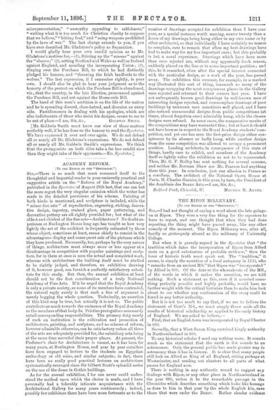ACADEMY REFORM.
LTO TIM EDITOR OF THE " SPECTATOR." j SIR,—There is so much that must commend itself to the thoughtful and impartial reader in your eminently practical and suggestive article on the " Reform of the Royal Academy," published in the Spectator of August 28th last, that one can but the more regret the very singular omission which the writer has made in the detailed provisions of his scheme. Painting of both kinds is mentioned, and sculpture is included, while the 4' minor fine arts" of reproduction, engraving, etching, decora- tive design, tapestry, stained glass, paper patterning, and decorative pottery are all rightly provided for ; but what of the -oldest and chiefest of the fine arts—Architecture ? No doubt ex- perience at Burlington House long ago has taught us how very lightly the art of the architect is frequently estimated by those whose object, sometimes at least, seems chiefly to consist in the advantageous display and consequent sale of the pictures which they have produced. Necessarily, too, perhaps by the very nature of things, architecture must always more or less appear at a disadvantage in competition with popular paintings and sculp- ture, for in them at once is seen the actual and completed work, whereas with architecture the building itself must be studied to be rightly judged, and therefore, no exhibition drawing of it, however good, can furnish a perfectly satisfactory substi- tute for this study. But then, the annual exhibition at least should not be the first consideration of a truly Nation61 Academy of Fine Arts. If it be urged that the Royal Academy is only a private society, as some of its members have contended, the natural reply surely is that such a line of argument is merely begging the whole question. Techcically, an assertion of this kind may be true, but actually it is not so. The public contribute as much towards the eminence of the Royal Academy as the members of that body do. Pristine prerogatives necessarily entail corresponding responsibilities. The primary duty surely of such an institution is the cultivation and promotion of -architecture, painting, and sculpture, and no scheme of reform, liowever admirable otherwise, can be satisfactory unless all three of the arts are adequately provided for, the subsidiary arts being at the same time accorded their proper places. At present, the Professor's chair for Architecture is vacant, as it has been for many years, at Burlington House, and year by year outsiders have been .engaged to lecture to the students on Egyptian arcbmology or old coins, and similar subjects; in fact, there have been no really good practical lectures on architecture systematically arranged since Sir Gilbert Scott's splendid series on the use of the dome in Gothic buildings.
As for the annual exhibition, I for one never could under- stand the method upon which the choice is made, and I have personally had a tolerably intimate acquaintance with the Architectural Gallery for many years continuously ; indeed, possibly few exhibitors there have been more fortunate as to the
number of drawings accepted for exhibition than I have (one year, as a special instance worth naming, nearer twenty than a dozen of my drawings being hung either in my own name or by other architects), so that individually I have certainly no reason to complain, save to remark that often my best drawings have had to make way for my less important ones ; but this probably is but a usual experience. Drawings which have been more than once rejected are, without any apparently fresh reason, suddenly placed on the line or in some important position ; and this, be it remarked, often after the special interest connected with the particular design, as a work of the year, has passed away. The exhibition this summer, for example, in a marked way illustrated this sort of thing, inasmuch as many of the drawings occupying the most conspicuous places in the Gallery were rejected and returned to their owners last year. I have not unfrequently known good drawings by well-known men of interesting designs rejected, and commonplace drawings of poor buildings by unknown men sometimes well placed, and I have also noticed unsuccessful designs from public competitions (at times, almost forgotten ones) admirably hang, while the chosen designs were refused. In some cases, the comparative merits of the compositions may have warranted this ; but at least it should not have been so in respect to the Royal Academy students' com- petition, and yet one has seen the first-prize design either con- spicuous by its absence or badly hung, while another design from the same competition was allowed to occupy a prominent position. Leading architects, in consequence of this state of things, hardly care to exhibit, and members of the Academy itself so lightly value the exhibition as not to be represented. Thus, Mr. G. F. Bodley has sent nothing for several seasons, and neither Mr. Norman Shaw nor Mr. Pearson had anything there this year. In conclusion, just one allusion to France as a corollary. The architect of the National Opera House at Paris, M. Charles Gamier, is this year, by turn, the President of the Acad6mie des Beaux Arts.—I am, Sir, &c.,


































 Previous page
Previous page